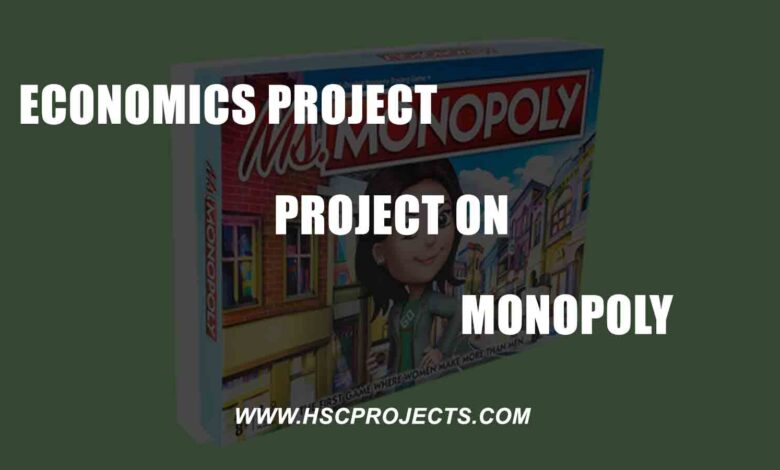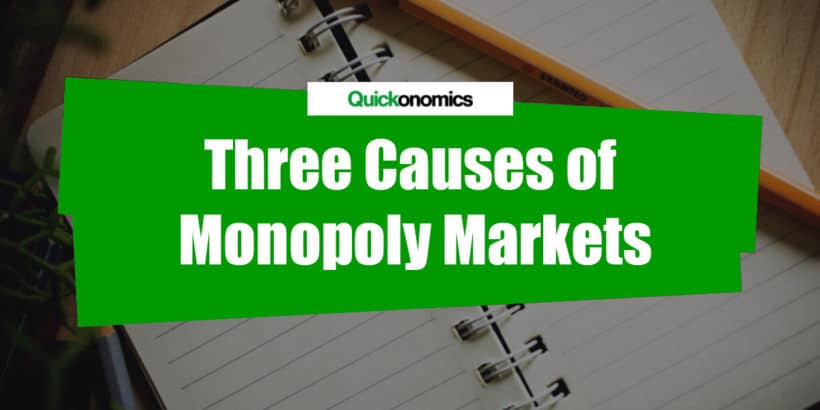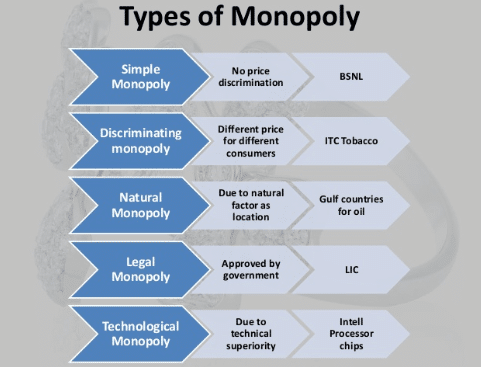
Economics Project on Monopoly – CBSE Class 12
MEANING OF MONOPOLY:
A monopoly is a market situation where there is only one seller of a product with barriers to entry and exit of others. The products have to close substitutes. The case elastically of demand with every product is shallow. Monopolistic can sell his commodity at any price he likes. He has control over cost. However, a monopolist can undoubtedly fix the rate at which he sells his product, but the amount of product cannot be determined that the purchaser will buy. If he charges a high price, the demand for a product will be less, and if he charges a low cost, the demand will increase.
FEATURES OF MONOPOLY:

- One Seller and a Large Number of Buyers: a Monopoly is a form of imperfect market structure where there is only one seller of a product. A monopoly firm may be owned by a person, a few members, or a joint-stock company. The characteristics feature of a single seller dominates the distinction between the firm and the industry.
- No Close Substitute: Under monopoly, a single producer produces single commodities that have no close substitute. As the commodity in question has no close substitute, the monopolist s at liberty to change the price according to his own choice. A monopoly cannot exist where there is competition. A firm is said to be monopolist only when it is the single producer and supplying the product.
- Strong Barriers to the Entry into the Industry Exist: In a monopoly market, there is a strong barrier to the entry of new firms. Monopolistic faces no competition. As there is no individual, rival producers can enter the market of the same product.
- Nature of Demand Curve: In the case of monopoly, one firm constitutes the whole industry. The entire demand of the consumers for a product goes to the monopolist. A monopolist can sell more of his output only at a lower price and can produce the sale at a higher price. The downward-sloping demand curve expresses that the price goes on falling as sales are increased.
- Patents: Patents are a tool that the Government uses to promote innovation as companies should be more willing to create new products if they have monopoly power over the products.
- Price Discrimination: A monopolist may charge the different prices for his product form different sets of consumers at the same time. It is known as ‘Price Discrimination.’
- Price Maker: In the case of monopoly, firms, and industries are the same thing. So, the firm has complete control over the industry output. As a result, a monopolist is a price maker and fixes its price. It can influence the market price by changing the supply of the product.
REASONS FOR EMERGENCE OF MONOPOLY:

The firm enjoys a monopoly when it is the sole seller of its product, and the product has no close substitutes. The fundamental cause of monopoly is the barrier to entry.
- Government Licensing:
It means that before a firm can enter an industry, it needs to take permission from the Government. The licensing is used to ensure minimum standards of compliance. By not granting licenses to new firms, the Government aims to ensure that only one firm operates in the market.
- Cartel:
Under Cartel, some firms retain their identities but coordinate their output and pricing policies to set as a monopoly. The firm agrees among themselves to restrict their output to the level that maximizes their joint profit. The most famous example of Cartel is the ‘Organization of Petroleum Exporting Countries’ (OPEC).
- Control on Raw Materials:
Monopoly also arises due to sole ownership or control of certain essential raw materials needed in a particular industry. For example, a beer company of South Africa controls about 80 percent of the world’s production of Diamonds. Although the share is not 100 percent, it still is large enough to extend substantial influence over the market.
WHY MONOPOLY ARISE?
Monopolies have existed throughout much of human history. This is because powerful force exists both for the creation and maintenance of monopolies. At the root of these forces is the natural human desire for wealth and power, together with the fact that monopolies can be immediately profitable and provide their owners with tremendous financial, political, and social power.
Monopolies can arise in some circumstances as the result of normal business practices that are characteristics of firms in a highly competitive industry. More specifically, monopolies can arise in any of the following, non-mutual, exclusive ways:
- By developing or acquiring control over a unique product that is difficult or costly for other companies to copy.
- By having a lower production cost than competitors. This can result from having a more efficient (i.e., more output per unit of input) production technique or from having access to a unique source of low-cost inputs.
This category includes natural monopolies. A natural monopoly exists for a product for which there is sufficient scale such that the product can be produced or supplied by a single company at a lower cost than by multiple competing companies. Examples include utilities such as railroads, pipelines, electric power transmission systems, and wired telephone systems.
A monopoly is a term by economists to refer to the situation in which there is a single seller of a product for which there are no close substitutes.
Government policy about monopolies can have a major effect not only on specific businesses and industries but also on the economy and society as a whole.
TYPES OF MONOPOLY:

Monopolies can be classified in various ways, including, according to the degree of monopoly power, the cause of the monopoly, the structure of the monopoly is about selling or buying.
Although monopoly is most often thought of as referring to the seller, it can also apply to buyers. Monophony is the opposite of a conventional monopoly in the sense that there is only a single buyer for a product for which there are multiple sellers. Some companies are both monophony and monopoly. By also being a monopolist, a monopoly can increase its profits even further by putting pressure on the companies that supply inputs for its products to reduce their prices.
Natural Monopoly:
A natural monopoly is a firm that experiences increasing returns to scale over the relevant range of output. A natural monopoly occurs where the average cost of production “declines throughout the relevant range of the product demand.” The relevant range of product demand is where the average cost curve is below the demand curve. When this situation occurs, it is always cheaper for one large firm to supply the market than multiple smaller firms. Absent government intersection in such markets will naturally evolve into a monopoly.
Government Granted Monopoly:
A Government Granted Monopoly is a form of coercive monopoly by which a government grants exclusive privilege to a private individual or firm to be the sole provider of a good or service. Examples of Government Granted Monopoly are Copyrights, Patents, and Trademarks.
MARKET STRUCTURES:
In economics, a monopoly is a pivotal area to the study of market structures, which directly concerns normative aspects of economic competition. It sets the foundations for fields such as industrial organization and economics. There are four types of market structures under traditional economic analysis.
Perfect Competition Monopolistic Competition – Oligopoly Monopoly:
A Monopoly is a market structure in which a single supplier produces and sells the product. If there is a single seller in a certain industry and there are no close substitutes for the goods being produced, then the market structure is that of a ‘pure monopoly.’ Sometimes there are many sellers in an industry, and there exist many close substitutes for the good being produced, but firms retain some market power.
MONOPOLY VS COMPETITIVE MARKETS:

While monopoly and perfect competition mark the extremes of market structures. There are many points of similarity. The cost functions are the same. There are distinctions, some of the more important which are as follows;
Market Power: Market Power is the ability to control the terms and conditions of exchange. All firms in a perfectly competitive market are price taken. A monopoly is a price maker.
Product Differentiation: There is 0 product differentiation in a perfectly competitive market. With a monopoly, there is high to absolute product differentiation in the sense that there is no available substitute for a monopolized good.
Number of Competitors: Perfect Competitive Markets are populated by an infinite number of buyers and sellers; a Monopoly involves a single seller.
WHY CAN MONOPOLIES BE HARMFUL?
Large monopolies have considerable potential to damage both economics and democratic government. Unfortunately, the full extent of the damage is usually not as obvious, at least to the general public, as are the seemingly beneficial effects.
- Substantially lower prices and higher levels of output than would exist if competitive companies produced the product.
- A lower level of quality than would otherwise exist. This includes not only the quality of the goods and services themselves but also the quality of the services associated with such goods and services.
The adverse effects of monopolies can be much more notice of an individual level than in the aggregate. These effects include the destruction of businesses that would have survived had competition been based solely on quality and price for production so high at to cause unaffordable for some people.
SPECIOUS ARGUMENTS FOR TOLERATING MONOPOLIES:
The arguments are often heard that “The Government should have monopolies alone because their success is a result of market competition.” This argument is very misleading for several reasons.
A second reason is that, even if a monopoly arises by fully legitimate means, there are strong temptation for it to engage (even unknowingly in practices that are bad for the economy as a whole kg higher prices, lower output, and less innovation than in a highly competitive situation), although such behavior and are usually not readily apparent political decision market.
Optimal Public Policy:
Public policy about monopolies should ideally is based on what is most efficient for the economy and society as a whole. For natural monopolies, it is generally most efficient to maintain the monopoly but subject it to Government Regulations about prices, quality of services, etc.
But if it is determined that a monopolist is changing prices substantially higher than, providing quality lower than, or being less innovative than would occur under competitive conditions or engaging in the abusive practice, then there is good cause to take aggressive action.
How the Government can intervene to reduce the adverse effects of monopolies can be classified into three broad categories:
1. Strengthening of existing competition, or promoting the emergence of new competition by promoting such means as encouraging innovations, providing Government contracts to competitions. When monopolies are permitted to exist, there are several types of policies that should be implemented to assure maximum benefit to the economy.
They include
- Outlawing price discrimination.
- It is outlawing the use of monopoly power about one product to gain a monopoly about other products.
- Setting standards for quality.
- I am restricting the direct or indirect political activities of the monopolist.
Expectations under Monopoly:
- Salt: Salt has a long history being a monopoly in much of the world because it is naturally scarce in many regions, and because of the strong demand for it. Salt Monopolists have been a very convenient way for Governments and large companies to have vast amounts of money. For example, the rise of Venice to greatness is attributed in large part of its salt monopoly.
- Airlines: Airlines are not generally considered to be monopolies because there is usually a choice of airlines as well as other models of transportation from which to choose. However, individual airlines often have substantial monopoly power on certain rates and for certain times because they might be the only choice for high-speed travel or shipping for a particular route on for that route at a certain time.
The exception would be if some company had a lower cost of production than the others, in which case it could become a monopoly if it caused expand its output sufficiently.
CASE STUDY:
In economics, a monopoly is defended as a persistent market situation where there is only one provider of a product or service. Monopolies are characterized by a lack of economic competition for the good or service that they provide and a lack of viable substitute goods.
A monopoly should be distinguished from a monopoly in which there is only one buyer of the product or services, and it should also strictly be distinguished from the phenomenon of a cartel.
Indian Railways (IR) is the state-owned railway company of India. Indian Railway had, until very recently, a monopoly on the country’s rail transport. It is one of the largest and subset rail networks in the world.
Case Study 1:
Standard Oil:
The oil industry was prone to a natural monopoly because of the rarity of the deposits. Rockefeller and his partners took advantage of both the rarity of oil and the revenue produced from it to set up a monopoly without the help of the banks.
Back when there were a lot of oil companies competing to make the most of their find, companies would often pump waste products into rivers or straight out on the ground rather than going to the cost of researching proper disposal. They often cut costs by using shoddy pipelines that were prone to leakage.
The benefits of having a monopoly-like standard oil in the country were only realized after it had built a nationwide infrastructure that no longer depended on trains and their notoriously fluctuating costs, a leap that would help reduce costs and the overall price of petroleum products after the company was dismantled. The size of standard oil allowed it to undertake projects that disparate companies could never agree on, and in that sense, it was beneficial.
Despite the eventual break of up of standard oil, the Government realized that a monopoly could build up a reliable infrastructure and delivered low-cost service to a broader base of consumers oil and the generous dividends also encouraged investors, and thereby the market, to invest in monopolistic firms, providing them with funds to grow larger.
Case Study 2:
AT&T and Microsoft:

AT&T was a Government supported monopoly a public utility that would have to be considered a coercive monopoly. Like standard oil, the AT&T monopoly made the industry more efficient and wasn’t guilty of fixing prices, but rather the potential to fix prices. The breakup of AT&T by Reagan in the 1980s gave birth to the baby bells. Since that time, many of the baby bells have begun to merge and increase in size to provide better service to a wider area.
Microsoft:
Microsoft, on the other hand, was never actually broken up even though it lost its case. The case against it was centered on whether Microsoft was essentially a non-coercive monopoly. Microsoft has been challenged by many companies, including Google over its Operating System’s continuing hostility to competitive software, even now, the Microsoft Monopoly is looking chipped at the edges as a rival operating system are gaining grounds.
ACKNOWLEDGMENT:
It gives me immense pleasure to be associated with this project. The project was a joyous learning process and helped me in learning and linking my theoretical knowledge with practical knowledge.
The present project has been completed under the supervision of my teacher Mrs. Indu Arun Sharma. I also would like to express my gratitude and sincere thanks to my principal, Sister Rozy Joseph, for the moral support extended during the tenure of the project. In the end, I am grateful to my parents, other faculty members of the school, and friends for their valuable suggestions given to me.
CERTIFICATE:
This is to certify that Miss Divya Bansal of Class XII B has completed her economics project file under the supervision and guidance of Mrs. Indu Arun Sharma for the partial fulfillment of the CBSE curriculum for the year 2017-2019.
BIBLIOGRAPHY:
Books:
V.K Ohri
Sandeep Garg
Internet:
www.slideshare.com
www.wikipedia.org
Newspaper:
The Times of India
DOWNLOAD PDF OF THE PROJECT

Password: hscprojects.com
DOWNLOAD PDF OF THE PROJECT

Password: hscprojects.com
In order to download the PDF, You must follow on Youtube. Once done, Click on Submit
Follow On YoutubeSubscribed? Click on Confirm
Download Economics Project on Monopoly – CBSE Class 12 PDF






